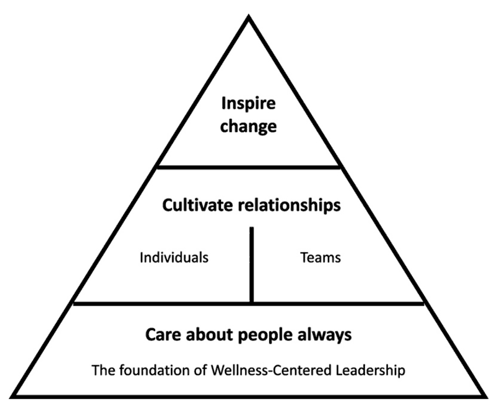In dealing with the urgent threats to well-being for physicians—burnout, moral injury and general dissatisfaction with the conditions under which they work—some leaders are putting in place dynamic programs that address these challenges. However, supporting well-being by merely responding to problems after they arise is not enough.

Being Proactive
In our recent article, Physician Well-Being and the Need for Proactivity, we detail that while it’s important for the organization to be able to respond to needs—have help available to physicians who experience distress—it is even more crucial to be proactive: to anticipate needs and make prevention a priority.
Keys to a proactive, prevention-focused approach is altering the “ecosystem” represented by the medical workplace so that physician well-being, as well as patient well-being, is key at every level.
That requires new approaches by leadership.
The Wellness-Centered Leadership Model
Luckily, there is a well-thought-out model for leadership to follow: Wellness-Centered Leadership (WCL) as articulated in a 2021 paper authored by, Tait Shanafelt, MD, one of the most prominent voices for physician well-being.
Leaders, the authors write, are often selected for clinical skill or their simple willingness to take on the task, rather than for possessing the skills that effective leadership requires.
Three Principles
The people-focused philosophy of WCL is built upon three basic principles
Care about people always. As the foundation of the pyramid, this value is imperative, Shanafelt and colleagues write.
“This starts with leaders recognizing the pivotal role their behaviors play in the professional fulfillment, vitality and wellness of their team members…. Leaders must emphasize integrity, servanthood and seeking the best for people. Caring leaders demonstrate respect, empathy and curiosity, and they continually seek to understand and validate the complex needs and contributions of individuals and teams.”
Cultivate individual and team relationships. Showing your physicians you understand and care about their day-to-day experiences at work helps foster a deep culture of care at your organization. An example of this is shadowing a physician during one of their shifts. This helps by showing interest, empathy and understanding of their work and creates an opportunity to cultivate a relationship with them.
“Health care is emotionally demanding work, and health care professionals are dependent on the support of their leaders and colleagues. Physicians work most effectively when they are part of a team that supports respectful relationships and provides meaning and purpose.”
Inspire change. To alter the healthcare ecosystem at your organization and utilize WCL is to truly inspire and drive change. This may be at the administrative level or the patient care level, but determining what needs to be changed to instill proactive well-being practices and inspiring and driving that forward is the ultimate goal.
“The wellness-centered leader inspires teams to think beyond the status quo, empowers them to drive change, and helps them achieve meaningful results. Teams and individual team members should be provided the greatest possible flexibility and control over how they accomplish group and organizational aims. This does not mean allowing physicians to do whatever they want; it’s about honoring physicians’ expertise and letting go of rigidity. “The concept that all variability is waste, that standardization should be pursued simply to facilitate easy scheduling and staffing, or that most aspects of clinical care can be homogeneous and reduced to algorithmic recipes must be rejected.”
It is an ambitious vision, given current conditions in the ecosystem; but establishing a truly effective proactive focus on physician well-being will require leadership to take its philosophy seriously. Click here to learn more.



